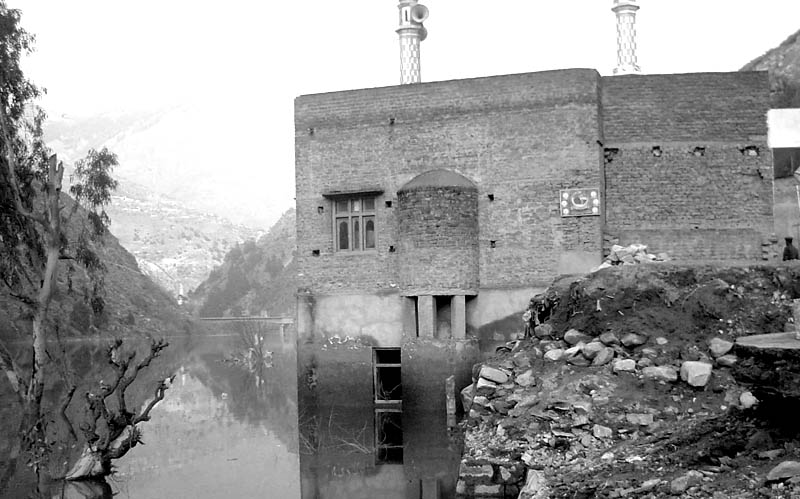Strained by mining, blasting and the Baghlihar water reservoir, the mountains in Doda-Kishtwar region are giving in. The twin districts remained cut-off for 18 days, but a bigger disaster may be in the making, R S GULL reports
The mighty Chenab is not at its high in winters, and so only two of the three units of Baglihar power project can run. The two generate around 600 thousand million units a day, says Sundip K Nayak, state’s Power Commissioner. The third unit is expected to run by April “once the water level is adequate”. But the residents of Kishtwar and Doda are bewildered.
Asim Hashmi, a young lawyer sums it up. “As the impounding of the Baglihar reservoir started, we were stunned by the conversion of fearsome river into a little ocean. And now you say it will still go up.”
Since November, when the impounding of the dam started, the water level of the river has gone up by 30 meters and by April it would cross 34. Hashmi and thousands of people in the area see the powerhouse reservoir responsible for the crisis that unfolded on February 5 when 150 meter road stretch between Trungal and Assar of the Batote-Kishtwar highway was washed away.
While Doda and Kishtwar were disconnected, Border Roads Organisation (BRO) was asked to create a link besides making the alternative Bani-Bhaderwah road operational by clearing it off snow.The crisis confounded with reports about 32 km stretch of road from Batote being unsafe. Bewildered residents of four more villages – Kudgran, Khutyara and Manklan and Koura Pani – panicked as they were on the verge of sinking. There were migrations from various places. Nepli is also under threat of getting submerged. From Massoo hamlet, authorities asked certain families to move out.
Zakir Ahmad, a resident told Kashmir Life that certain people were still living in Pul Doda, a highway trade centre where authorities say they have already paid Rs 12.50 crore for rehabilitating 241 families whose properties have submerged. “We have a mosque whose ground floor is under water. People pray in the first floor. We call it floating mosque now,” Ahmad said. Near Assar’s gypsum mines, fresh cracks have forced authorities to halt mining. Officials admit they are monitoring Neibeli and Malhori belts having history of rock sliding. They claim they had forewarned the residents about the crisis except for the receding of the road stretch.
“We had already released the allocated Rs 18 crores for the rehabilitation of the population that we knew would be affected. We have already notified it and we can not help if people still live dangerously,” a senior official said pleading anonymity.
Though the highway was restored for traffic on 25th of February after 18 days, the crisis has triggered a debate with different agencies blaming one another.
“If sinking of road at Assar is linked to Baglihar, what are the factors that trigger landslides and erosion at Ramban and Nashri,” asks a senior power ministry official. “The mountains are very young and unstable. They need a special treatment during road widening.” While the roads in these areas continue to be unsafe for traffic, an alternative road is being upgraded to ‘National Highway’ specifications to connect Doda with Kokernag in Kashmir via Semthan Pass. The work has been going on for two decades. The completion though is a distant dream. (See Box) Interestingly, BRO, Power Development Corporation and the state mining department have already sent their teams of geologists to study the fragile eco-system in the Assar belt on Batote Doda road. Their reports, if and when submitted, will trigger another round of debate.
Apart from noticing “complete lack of coordination” between different agencies, a team of Geology and Mining experts have detected three fault zones on Pul Doda-Assar section of the road at Kora Pani, Neibli and Assar. They see the alternative bye-pass laid by BRO as unsafe. Blasts for road laying and mining have accelerated the erosion of land that has tendency to absorb more water. Many think the road and the dam is proving a dangerous cocktail.
“The entire road was prone to soil erosion and land slides. But this was not taken into consideration when the project came up. It (project) has disrupted its (rivers) normal course (forcing it) to start lateral cutting,” says Prof S A Qazi, Geography teacher at the Bhaderwah Degree College.
In a category-V seismic zone, quite a few people know, the fault-line passes through the Baglihar dam itself. When geologists at Jammu University raised the issue with the then Chief Minister Dr Farooq Abdullah, his response was peculiar, “Really! It will be good that in case of a Baglihar breach entire Pakistan will get washed away.” “Tragedy is that he forgot that it will be Aknoor first,” a JU teacher told Kashmir Life.
Interestingly both Akhnoor and Pakistan are safe for now; it is Doda paying the price!
















